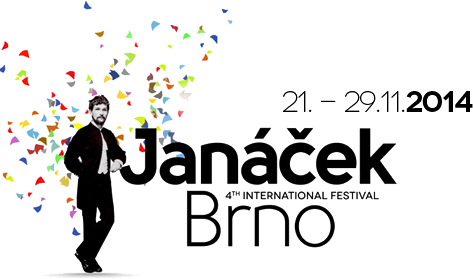Brno Philharmonic
ANTONÍN DVOŘÁK (1841–1904)
Fanfares for the Festive Opening of the Jubilee Exhibition in Prague (1891)
BÉLA BARTÓK (1881–1945)
Concerto No. 1 for piano and orchestra
Allegro moderato – Allegro
Andante – attacca
Allegro molto
MARC-ANDRÉ DALBAVIE (1961)
Variations on a theme by Janáček
strong>LEOŠ JANÁČEK (1854–1928) Sinfonietta
Allegretto (Fanfare)
Andante (Hrad, Brno)
Moderato (The Queen’s Monastery, Brno)
Allegretto (The Street Leading to the Castle)
Andante con moto (The Town Hall, Brno)
Denis Kozhukhin – piano
Aleksandar Marković –conductor
This concert will get off to a suitably festive start – with fanfares, which, although written by Antonín Dvořák (1841–1904), will be unfamiliar to listeners. Dvořák wrote the Fanfares for four trumpets and timpani for the opening of the Jubilee Exhibition held in Prague in 1891. From six o’clock in the morning on 15 May, the day of the exhibition opening, the fanfares sounded from Prague’s towers, and on the same day, during the gala opening of the exhibition, they were played from the gallery of the entrance gate to the exhibition grounds. Unlike Dvořák’s musical notes, which called for four trumpeters, for the exhibition their number was raised to sixteen. An interesting feature of the fanfares is the almost identical form of the basic timpani figure to the children’s nursery rhyme “Ho, ho, there the cows go” and the almost identical melodic outline to the Austrian imperial anthem.
Béla Bartók (1881–1945) wrote of his First Piano Concerto, “Over the last year I’ve been studying music prior to Bach and I imagine some traces of that can be seen, for example, in my Piano Concerto…” Bartók worked on it from August until November 1926 and eventually he was the first to perform it under the baton of Wilhelm Furtwängler. The premiere took place in July 1927 at the International Contemporary Music Society festival in Frankfurt It is interesting to note that he personally played this new work in Prague in 1927 with the Czech Philharmonic. The composer also engaged in lengthy discussions about the work with Leoš Janáček. Bartók and Janáček shared an interest in folk music, which was a strong source of inspiration for both of them.
The French composer Marc-André Dalbavie (1961) was commissioned to write a new work by the prestigious Suntory Hall in Tokyo. Dalbavie wrote the twenty-minute Variations on a Theme by Janáček for this concert hall and personally conducted the premiere there in 2006. Dalbavie dedicated the composition to the composer Henri Dutilleux. The Variations have also been performed by the famous Orchestre de Paris. The Janáček theme was borrowed from the piano cycle In the Mists. It is also worth noting that Dalbavie was inspired by Janáček in his Sinfonietta.
And it is in fact Leoš Janáček’s (1854–1928) Sinfonietta which brings the Brno Philharmonic’s concert to a close. Janáček completed it in 1926, and it proved to be his last orchestral work. The composition was dedicated to Václav Talich and was first conducted by him as part of the 8th Sokol Rally in Prague with the Czech Philharmonic on 26 June of the same year in the Municipal House. The concert was broadcast on radio. The critics rated the Sinfonietta alongside the symphonic rhapsody Taras Bulba as the pinnacles of Janáček’s orchestral work, an evaluation which remains true to this day. On 4 December 1927 Janáček’s article Meine Stadt was published in the Prager Presse and it was published in Czech on 24 December of the same year as Moje město (My City). In this short text Janáček wrote about the milestones in his life from childhood experiences from the period of the Prussian-Austrian war of 1866, through other mostly bleak experiences, to the day when the Czechoslovak Republic was declared: “And suddenly I saw the city miraculously transformed. […] Above the city shone the enchanting glow of freedom, the rebirth of 28 October 1918! I looked into it, I belonged to it. And from the sound of the victorious trumpets, the holy calm in the Queen’s Monastery on Úvoz, the night-time shadows and the breath of green hills and the sight of this distinct growth and size of the city, a sinfonietta grew inside me from this knowledge, from my city of Brno!” Here Janáček combined the experience of the end of the war with the establishment of Czechoslovakia in his composition. The Sinfonietta, at first called Military Sinfonietta by the composer (and presented as Rally Sinfonietta at the premiere) was originally meant to be played outdoors. Gradually, however, it grew to be a work of symphonic stature. The opening fanfare movement is played by brass instruments and timpani, and it recurs in expanded form in the fifth movement. The middle movement describes that “holy calm of the Queen’s Monastery”, while the second and fourth movements frame it with contrasting styles. For the Prague premiere Janáček provided programme names for each movement – Fanfares, Castle, Queen’s Monastery, Street and Town Hall. Later these titles were dropped and the simpler Sinfonietta was retained. The composition was dedicated to the patroness Rosa Newmarch, who in 1926 facilitated Janáček’s artistic trip to England. In December 1926 Otto Klemperer conducted the Sinfonietta in Wiesbaden, and during Janáček’s lifetime there followed performances in Brno, Berlin, London, Vienna and Dresden.
Pavel Petráněk







